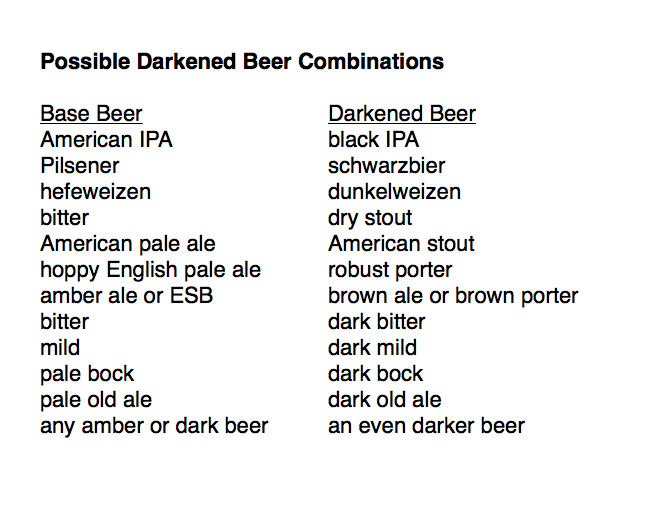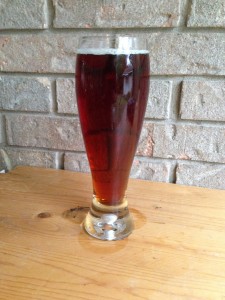 One of the great things about homebrewing is the ability to have a variety of beers on tap at once. If you enjoy having more types of beer at your disposal, one option is to make beers that are meant to be blended. In the best cases, you can have two beers that taste great on their own, and additionally make a tasty blend.
One of the great things about homebrewing is the ability to have a variety of beers on tap at once. If you enjoy having more types of beer at your disposal, one option is to make beers that are meant to be blended. In the best cases, you can have two beers that taste great on their own, and additionally make a tasty blend.
Another alternative is to brew a beer you like, then brew another beer that darkens it. There are a variety of beers that are basically darkened versions of an existing beer style. For example, schwarzbier is basically a darkened Pilsner, dunkelweizen is a darkened hefeweizen, and black IPA is a darkened IPA. If you can brew a very dark beer, you can use it to blend into lighter beers to make the darker variation.
A few years ago, I tried this and discovered that — while the basic idea was sound — there were some obstacles that need to be overcome. Specifically, the darker the blending beer, the more it was likely to be of poorer quality. Making a very dark beer, darker than a normal porter or stout, requires some manipulation of your water chemistry in order to get the mash to work. Plus, for some reason, the dark grain character of beers made from blending a pale beer with a super dark blending beer gets worse as the color depth of the blending beer increases. (And I have no idea why that is. Keep in mind that I am talking about dark blending beers brewed many times darker than a regular stout.)
However, if you plan your pair of beers well, and follow a few guidelines with regards to the dark blender, the process can work extremely well. You can essentially have two beers for every beer you brew, or expand your range of beers you serve at your homebrew parties. Today, I’ll lay out the bare bones of this idea. In later installments, I’ll make some suggestions for brewing very dark blending beers and give specific instructions for a few beer pairings.
Planning and Example
 The first thing you need to decide is how dark to make your blending beer. The darker it is, the more beer it can transform. For example, if you made a 20X dark beer — twenty times as dark as your intended beer — one keg of the dark beer could transform 19 kegs of the paler beer into 20 kegs of the dark beer. However, the darker your blender is, the more potential problems you can face in the mash. Also, the dark grain character can suffer when extremely dark blenders are brewed.
The first thing you need to decide is how dark to make your blending beer. The darker it is, the more beer it can transform. For example, if you made a 20X dark beer — twenty times as dark as your intended beer — one keg of the dark beer could transform 19 kegs of the paler beer into 20 kegs of the dark beer. However, the darker your blender is, the more potential problems you can face in the mash. Also, the dark grain character can suffer when extremely dark blenders are brewed.
In practice, I’ve found that it is better to make smaller amounts of the blending beer, at a much lower color. For example, let’s say you brew 5.0 gallons (19 L) of (regular) IPA. If you brew 1.25 gallons (4.7 L) of dark beer at 2X the color you intend, you can blend the beer to make 3.75 gallons (14 L) of black IPA and have 2.5 gallons (9.5 L) of regular IPA to enjoy on its own.
If you make a 2X dark beer, your black IPA blend will be one part IPA and one part dark blending beer. You would, of course, brew you IPA as you normally would. Let’s assume you brew 5.0-gallon (19-L) batches. As I mentioned above, you could make 1.25 gallons (4.7 L) of dark blending beer and drank half the IPA as IPA and the rest as black IPA. The volume of blender would mean you actually end up with more black IPA — 3.75 gallons (14 L) — when blended. But you can adjust the amount of dark beer you make depending on how much IPA you want to blacken.
The recipe for the dark blender should mirror your IPA recipe — same base malts, same OG, same hops, same IBUs — except for having twice the amount of dark grains that a black IPA would require. Notice that this is not an insanely dark beer. If you wanted, you could try a 4X blender. However, at 2X, you simply need adjust your water chemistry to produce a “normal” dark beer and not have to go to any extreme measures. In this case, the blender might even make a decent hoppy porter. (In later installments, I will discuss the adjustments required for increasing dark blending beers.)
When the beers are finished, conditioned, and carbonated, you are ready to blend. Both beers will have had the same OG, share the same hop bill, show the same level of bitterness, and be the same in every respect except for the IPA being pale and the dark blender being twice as dark as a black IPA. (The dark beer may also have a higher final gravity (FG), due to the higher amount of unfermentable carbohydrates in the dark grains.) Whether you keg or bottle, you would simply mix the two beers 1:1 when you serve to produce your black IPA. You could also, of course, experiment with other blend ratios.
Uses
 You can use this method with specific pairs of light and dark beers in mind. If you enter homebrew contests, you could potentially double your number of entries by simply brewing one or more dark blending beers to complement your existing lineup. You could also make a “generic” dark blender — at an OG and level of bitterness near the median of the beers you usually brew — to add some color depth (and perhaps some roast flavor) to any of your beers.
You can use this method with specific pairs of light and dark beers in mind. If you enter homebrew contests, you could potentially double your number of entries by simply brewing one or more dark blending beers to complement your existing lineup. You could also make a “generic” dark blender — at an OG and level of bitterness near the median of the beers you usually brew — to add some color depth (and perhaps some roast flavor) to any of your beers.
—
Related Articles

Speak Your Mind